Articles
- Page Path
- HOME > J Musculoskelet Trauma > Volume 32(1); 2019 > Article
- Original Article Surgical Outcomes of the Monteggia Type 2 Fracture Dislocation in Adults
- Sung Choi, Daegeun Jeong, Youngsoo Byun, Taehoe Gu, Sungsoo Ha, Dongju Shin
-
Journal of Musculoskeletal Trauma 2019;32(1):6-13.
DOI: https://doi.org/10.12671/jkfs.2019.32.1.6
Published online: January 31, 2019

2Department of Orthopaedic Surgery, Gyeongsan Joongang Hospital, Gyeongsan, Korea.

- 557 Views
- 2 Download
- 0 Crossref
- 0 Scopus
Abstract
PURPOSE
This study examined clinical outcomes of Monteggia fracture type 2, which is the most common in adults with a high rate of accompanied injuries.
MATERIALS AND METHODS
From June 2004 to November 2015, a retrospective study was performed on 12 patients diagnosed with Monteggia fracture type 2 with a follow-up period of at least 6 months after surgery. The clinical outcomes were evaluated using the Mayo elbow performance score (MEPS), and the existence of accompanied injures, radiological result, and complications were analyzed.
RESULTS
Posterior instability was confirmed in all patients and accompanied fractures were detected in 9 patients (75.0%) on the radial head, whereas 10 patients (83.3%) were found on the coronoid process. The average arc of motion was 107° (70°–130°) and the mean MEPS was 89 (45–100). Additional re-operation due to re-dislocation, radioulnar synostosis, elbow instability, ulna nonunion, and radial head nonunion were performed in 4 cases (33.3%).
CONCLUSION
The Monteggia fracture type 2 is more commonly associated with radial head fractures and coronoid process fractures rather than other types, which causes elbow instability. Because the rate of additional surgery due to complications is high, the treatment of Monteggia fracture type 2 requires careful assessments.
Published online Jan 25, 2019.
https://doi.org/10.12671/jkfs.2019.32.1.6
Surgical Outcomes of the Monteggia Type 2 Fracture Dislocation in Adults
 , M.D.,
Daegeun Jeong
, M.D.,
Daegeun Jeong , M.D.,*
Youngsoo Byun
, M.D.,*
Youngsoo Byun , M.D., Ph.D.,
Taehoe Gu
, M.D., Ph.D.,
Taehoe Gu , M.D.,
Sungsoo Ha
, M.D.,
Sungsoo Ha , M.D.
and Dongju Shin
, M.D.
and Dongju Shin , M.D., M.S.
, M.D., M.S.
Abstract
Purpose
This study examined clinical outcomes of Monteggia fracture type 2, which is the most common in adults with a high rate of accompanied injuries.
Materials and Methods
From June 2004 to November 2015, a retrospective study was performed on 12 patients diagnosed with Monteggia fracture type 2 with a follow-up period of at least 6 months after surgery. The clinical outcomes were evaluated using the Mayo elbow performance score (MEPS), and the existence of accompanied injures, radiological result, and complications were analyzed.
Results
Posterior instability was confirmed in all patients and accompanied fractures were detected in 9 patients (75.0%) on the radial head, whereas 10 patients (83.3%) were found on the coronoid process. The average arc of motion was 107° (70°–130°) and the mean MEPS was 89 (45–100). Additional re-operation due to re-dislocation, radioulnar synostosis, elbow instability, ulna nonunion, and radial head nonunion were performed in 4 cases (33.3%).
Conclusion
The Monteggia fracture type 2 is more commonly associated with radial head fractures and coronoid process fractures rather than other types, which causes elbow instability. Because the rate of additional surgery due to complications is high, the treatment of Monteggia fracture type 2 requires careful assessments.
Fig. 1
A 66-year-old woman fell on the ground and injured her left elbow (Jupiter's Type 2A fracture dislocation associated with a radial head fracture and coronoid process fracture). (A) Initial anteroposterior. (B) Initial lateral view. (C, D) Three-dimensional computed tomography. (E) Anteroposterior view 32 months after the open reduction and internal fixation of ulna, replacement of the radial head and repair of medial collateral ligament & lateral collateral ligament. (F) Lateral view 32 months after surgery. (G) On the last follow-up, 32 months after surgery, range of motion=10°–125°, Mayo elbow performance score=100 (excellent).
Fig. 2
A 39-year-old woman fell from a height and injured her left elbow (Jupiter's Type 2C fracture dislocation associated with radial head fracture). (A) Initial anteroposterior & lateral views. (B) Postoperative anteroposterior & lateral views after open reduction and internal fixation & radial head excision. (C) Metal failure 3 months after surgery. (D) Postoperative anteroposterior & lateral views after 2nd surgery. On the last follow-up at 57 months after 2nd surgery, range of motion=20°–100°, Mayo elbow performance score=75 (good) with elbow instability.
Fig. 3
A 22-year-old woman fell from a height and injured her right elbow (Jupiter's Type 2D fracture dislocation associated with the radial head fracture and coronoid process fracture). (A) Initial lateral view. (B) Postoperative lateral view. (C) Lateral view 3 weeks after surgery (instability of elbow joint). (D) Postoperative lateral view after the 2nd surgery (additional plate fixation at coronoid process). (E) Radioulnar synostosis 18 months after the 2nd surgery. (F) Postoperative anteroposterior view after the 3rd surgery (ostectomy & partial implant removal). On the last follow-up of 25 months after the first surgery and range of motion=10°–120°, Mayo elbow performance score=95 (excellent).
Fig. 4
A 40-year-old man injured by a motor cycle traffic accident and injured his right elbow (Jupiter's Type 2C fracture dislocation associated with lateral ulnar collateral ligament rupture). (A) Initial anteroposterior & lateral views. (B) Postoperative anteroposterior & lateral views after open reduction and internal fixation. (C) Elbow instability 9 days after surgery. (D) Reconstruction of the lateral ulnar collateral ligament with palmaris longus tendon & postoperative anteroposterior & lateral views after 2nd surgery. On the last follow-up 34 months after the 2nd surgery, range of motion=20°–126°, Mayo elbow performance score=100 (excellent).
Table 1
Demographics of the Patients
Table 2
Jupiter's Subclassification
Financial support:None.
Conflict of interests:None.
References
-
O'Driscoll SW. Classification and evaluation of recurrent instability of the elbow. Clin Orthop Relat Res 2000;(370):34–43.
-

 E-submission
E-submission KOTA
KOTA TOTA
TOTA TOTS
TOTS
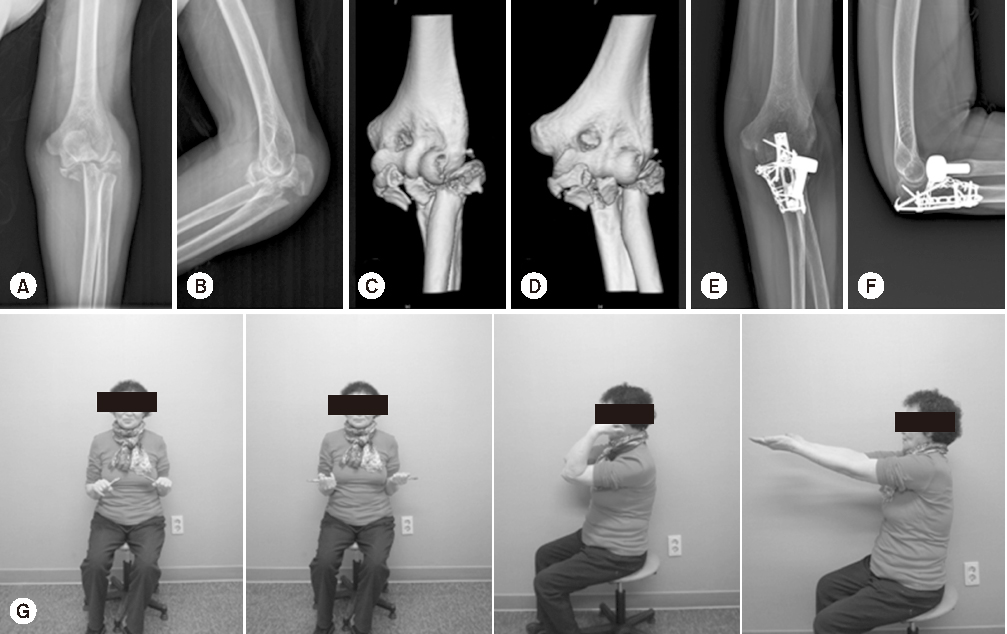
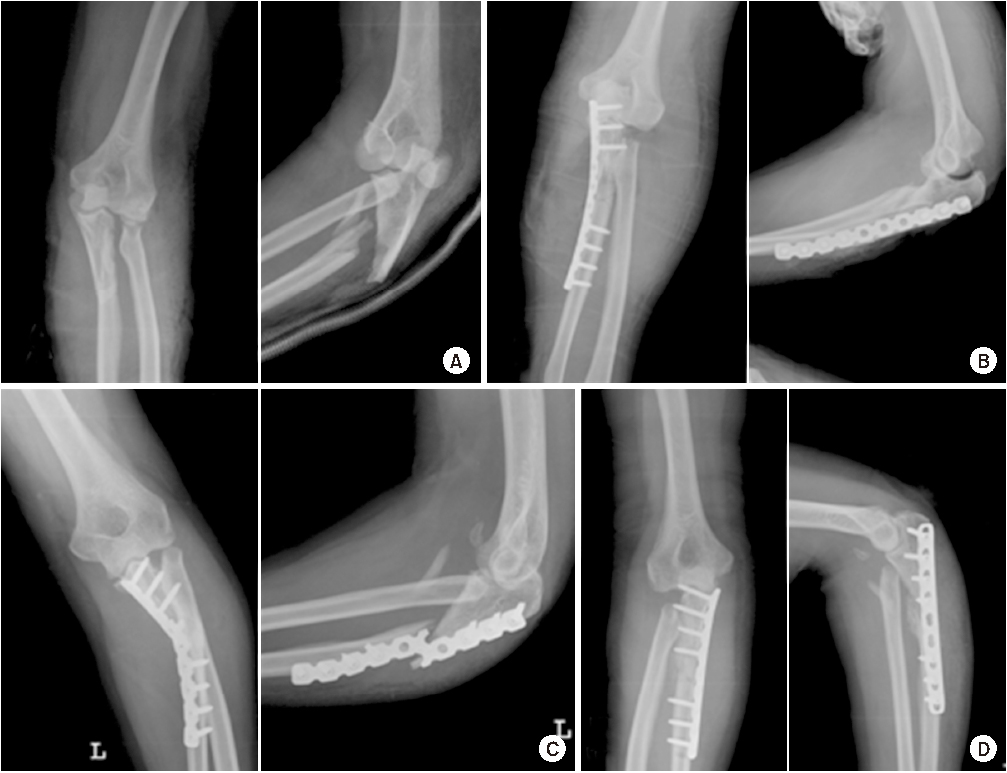
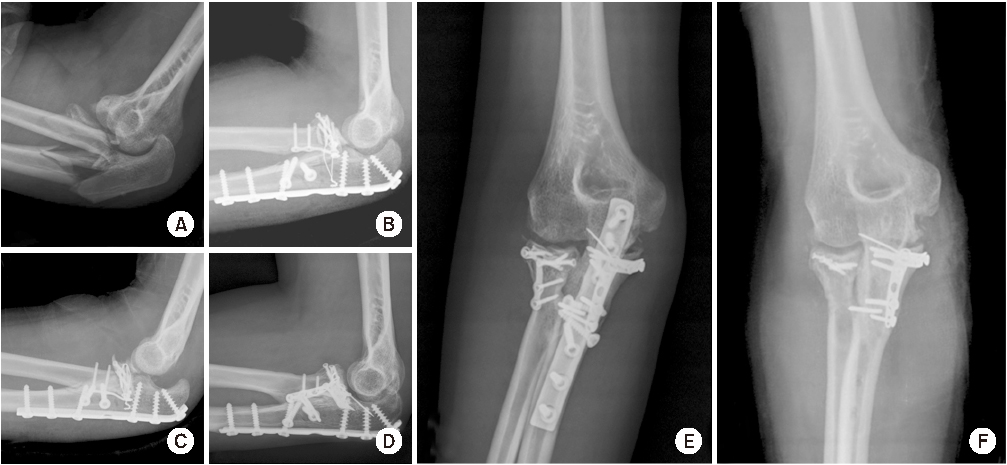
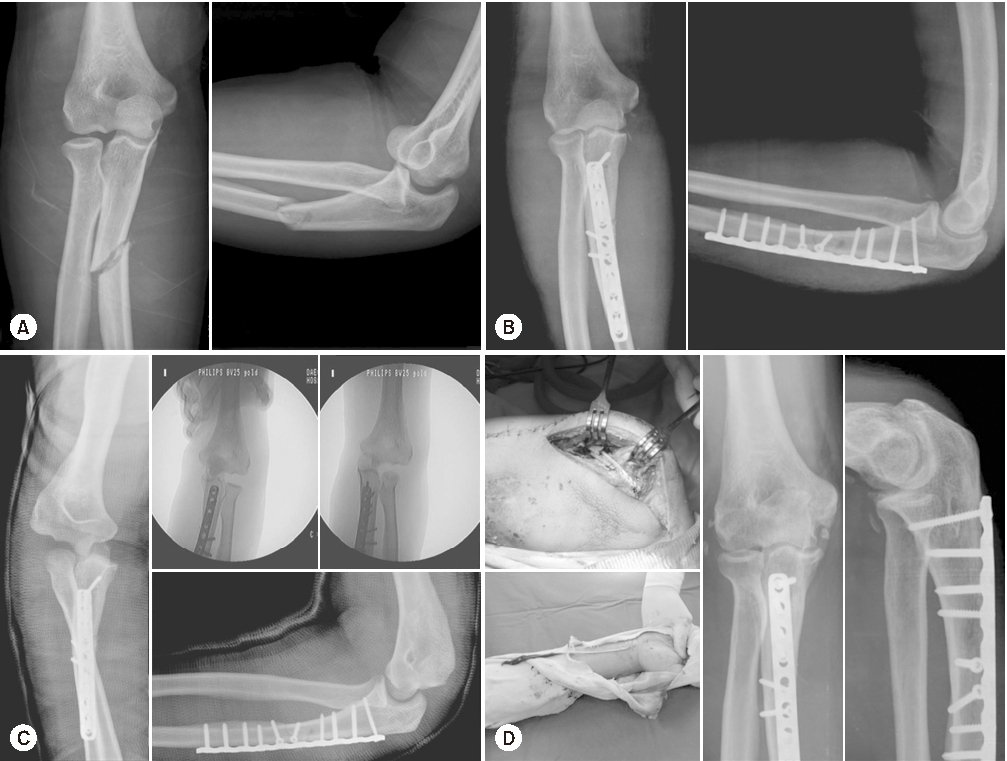
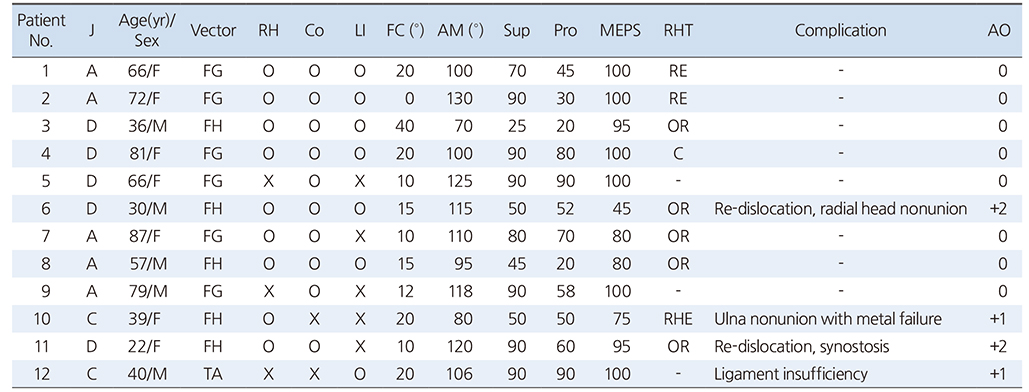


 PubReader
PubReader Cite
Cite

